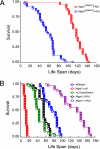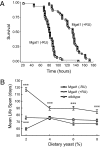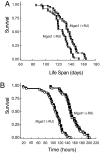Neuronal expression of Mgat1 rescues the shortened life span of Drosophila Mgat11 null mutants and increases life span
- PMID: 20457894
- PMCID: PMC2906912
- DOI: 10.1073/pnas.1004431107
Neuronal expression of Mgat1 rescues the shortened life span of Drosophila Mgat11 null mutants and increases life span
Abstract
The enzyme UDP-GlcNAc:alpha3-D-mannoside beta1,2-N-acetylglucosaminyltransferase I (GnT1, encoded by Mgat1) controls the synthesis of paucimannose N-glycans in Drosophila. We have previously reported that null mutations in Drosophila Mgat1 are viable but exhibit defects in locomotion, brain abnormalities, and a severely reduced life span. Here, we show that knockdown of Mgat1 in the central nervous system (CNS) of wild-type flies decreases locomotor activity and life span. This phenotype is similar to that observed in Drosophila Mgat1(1) null mutants, demonstrating that Mgat1 is required in the CNS. We also found that neuronal expression of a wild-type Mgat1 transgene rescued the shortened life span of Mgat1(1) null mutants and resulted in a dramatic 135% increase in mean life span relative to genetically identical controls. Neuronal expression of a wild-type Mgat1 transgene in wild-type flies resulted in a modest 9% increase in mean life span relative to genetically identical controls. In both Mgat1(1) null mutants and wild-type flies, neuronal expression of wild-type Mgat1 transgene resulted in a significant increase in GnT1 activity and resistance to oxidative stress. Whereas dietary restriction is not absolutely essential for the increased life span, it plays a role in the process. Interestingly, we observe a direct correlation between GnT1 activity and mean life span up to a maximum of appropriately 136 days, showing that the ability of GnT1 activity to increase life span is limited. Altogether, these observations suggest that Mgat1-dependent N-glycosylation plays an important role in the control of Drosophila life span.
Conflict of interest statement
The authors declare no conflict of interest.
Figures



Similar articles
-
Life is sweet! A novel role for N-glycans in Drosophila lifespan.Fly (Austin). 2011 Jan-Mar;5(1):18-24. doi: 10.4161/fly.5.1.13920. Epub 2011 Jan 1. Fly (Austin). 2011. PMID: 21057214 Free PMC article. Review.
-
Null mutations in Drosophila N-acetylglucosaminyltransferase I produce defects in locomotion and a reduced life span.J Biol Chem. 2006 May 5;281(18):12776-85. doi: 10.1074/jbc.M512769200. Epub 2006 Mar 7. J Biol Chem. 2006. PMID: 16522637
-
N-glycosylation requirements in neuromuscular synaptogenesis.Development. 2013 Dec;140(24):4970-81. doi: 10.1242/dev.099192. Epub 2013 Nov 13. Development. 2013. PMID: 24227656 Free PMC article.
-
The directed migration of gonadal distal tip cells in Caenorhabditis elegans requires NGAT-1, a ß1,4-N-acetylgalactosaminyltransferase enzyme.PLoS One. 2017 Aug 17;12(8):e0183049. doi: 10.1371/journal.pone.0183049. eCollection 2017. PLoS One. 2017. PMID: 28817611 Free PMC article.
-
Mgat1-dependent N-glycans are essential for the normal development of both vertebrate and invertebrate metazoans.Semin Cell Dev Biol. 2010 Aug;21(6):609-15. doi: 10.1016/j.semcdb.2010.02.010. Epub 2010 Mar 3. Semin Cell Dev Biol. 2010. PMID: 20206280 Review.
Cited by
-
Structure-function analysis of endogenous lectin mind-the-gap in synaptogenesis.Dev Neurobiol. 2012 Aug;72(8):1161-79. doi: 10.1002/dneu.22006. Epub 2012 Jun 25. Dev Neurobiol. 2012. PMID: 22234957 Free PMC article.
-
The N's and O's of Drosophila glycoprotein glycobiology.Glycoconj J. 2013 Jan;30(1):57-66. doi: 10.1007/s10719-012-9442-x. Epub 2012 Aug 31. Glycoconj J. 2013. PMID: 22936173 Free PMC article. Review.
-
Neural-specific α3-fucosylation of N-linked glycans in the Drosophila embryo requires fucosyltransferase A and influences developmental signaling associated with O-glycosylation.Glycobiology. 2010 Nov;20(11):1353-65. doi: 10.1093/glycob/cwq119. Epub 2010 Aug 5. Glycobiology. 2010. PMID: 20688784 Free PMC article.
-
Classical galactosaemia: novel insights in IgG N-glycosylation and N-glycan biosynthesis.Eur J Hum Genet. 2016 Jul;24(7):976-84. doi: 10.1038/ejhg.2015.254. Epub 2016 Jan 6. Eur J Hum Genet. 2016. PMID: 26733289 Free PMC article.
-
Life is sweet! A novel role for N-glycans in Drosophila lifespan.Fly (Austin). 2011 Jan-Mar;5(1):18-24. doi: 10.4161/fly.5.1.13920. Epub 2011 Jan 1. Fly (Austin). 2011. PMID: 21057214 Free PMC article. Review.
References
-
- Henrissat B, Surolia A, Stanley P. A genomic view of glycobiology. In: Varki A, et al., editors. Essentials of Glycobiology. 2nd Ed. Cold Spring Harbor, NY: Cold Spring Harbor Lab Press; 2008. pp. 89–99.
-
- Schachter H. The ‘yellow brick road’ to branched complex N-glycans. Glycobiology. 1991;1:453–461. - PubMed
-
- Schachter H. The joys of HexNAc. The synthesis and function of N- and O-glycan branches. Glycoconj J. 2000;17:465–483. - PubMed
-
- Stanley P, Schachter H, Taniguchi N. N-glycans. In: Varki A, et al., editors. Essentials of Glycobiology. 2nd Ed. Cold Spring Harbor, NY: Cold Spring Harbor Lab Press; 2008. pp. 101–114.
-
- Sarkar M, et al. Null mutations in Drosophila N-acetylglucosaminyltransferase I produce defects in locomotion and a reduced life span. J Biol Chem. 2006;281:12776–12785. - PubMed
Publication types
MeSH terms
Substances
Grants and funding
LinkOut - more resources
Full Text Sources
Molecular Biology Databases

